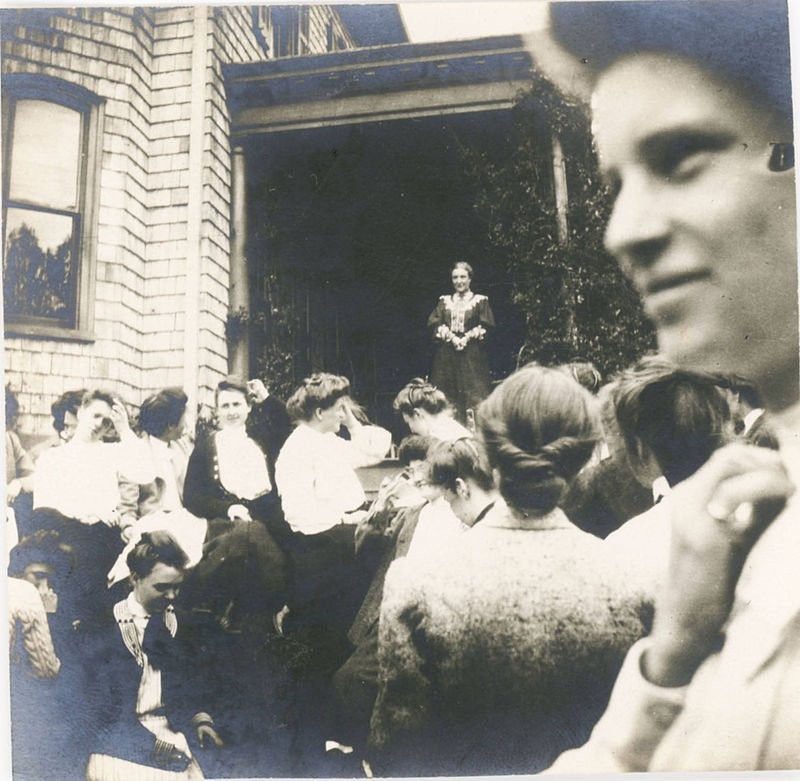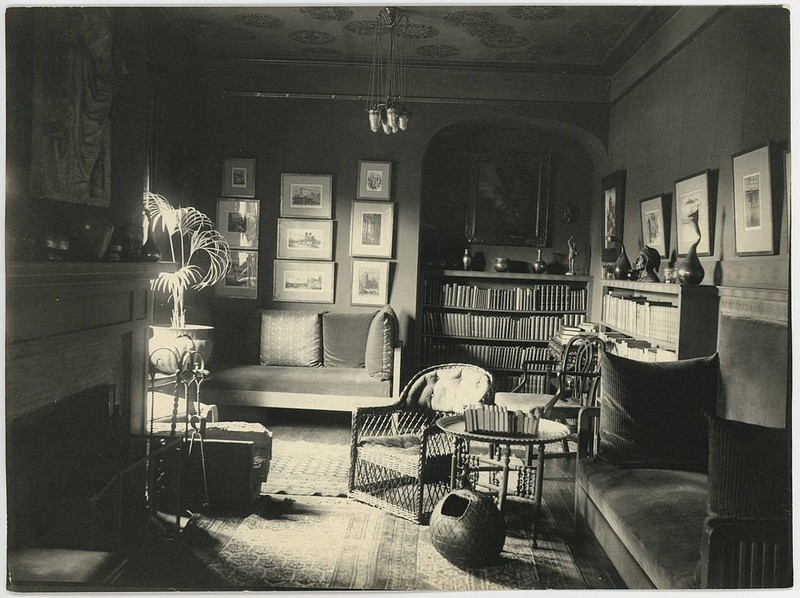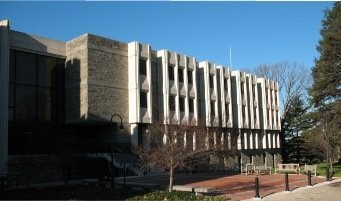The Deanery (1885-1968) and Canaday Library, Bryn Mawr College
Introduction
Text-to-speech Audio
Constructed in 1968, Canaday Library is located at the former site of Bryn Mawr College's Deanery, which was home to college leaders from the time of the college's first dean and second president, Dr. Martha Carey Thomas. Thomas lived at the home from 1885 to 1933, and at that time, the structure held only five rooms but contained works by Louis Comfort Tiffany and other influential designers and artists. The home was also full of items from Dr. Thomas' global travels and the college inherited the home and these items when she passed away in 1935. The home was later expanded significantly for entertaining guests and hosting events but demolished in 1968 above the protests of many students, faculty, and alumni in order to make room for the modern Canaday Library.
Images
Bryn Mawr's first president M. Carey Thomas addresses students from the porch of the home in 1905.

President Thomas' study photographed in 1904

Canaday Library at Bryn Mawr College

Backstory and Context
Text-to-speech Audio
Bryn Mawr College, named after the estate upon which it was constructed, was the first college in the United States to offer women a path to graduate education up to the level of the Ph. D. Beginning in 1885, Bryn Mawr staunchly challenged the restrictive gender norms placed on women at the time, giving women access to the arts and sciences that was unprecedented in the United States and had few predecessors in the world as a whole. Bryn Mawr now stands proudly as one of the most storied educational institutions in the United States and as a cornerstone of the Bryn Mawr community.
The founding of the College of Bryn Mawr was carried out at the behest of Joseph W. Taylor, a Quaker physician, following his death in 1880. For years prior to his death, Taylor had begun to organize the formation of a school that would provide unique educational opportunities "for the advanced education of females," with the bulk of his efforts occurring in 1879, a year before his death. In his will, he left his plans for the school and a considerable monetary sum with which to establish the institution. His goal was to provide a place that would allow women to perform their own, original research, which was previously available to very few men, let alone women at the time.
Taylor also hoped to inspire strongly in his students the morals and ideals of the Quakers, though it is noted by the College's historians that his trustees prioritized education to faith and chose to make the school non-denominational.
The first dean of the school was a woman by the name of M. Carey Thomas, whose vision for the school would shape its future for decades to come. She was known for her relentless pursuit of knowledge, leaving to study in Europe after being denied from American universities on the basis of gender. Under her leadership, Bryn Mawr became an influence on women's education nationwide and beyond.
Bryn Mawr, though, was not without flaw under the leadership of M. Carey Thomas, and school historians make a point to note that during this era of the school's history, the school leadership, including Thomas herself, held the oddly hypocritical and racially-prejudiced belief that education was reserved for white, wealthy women only. This severe flaw in approach, thankfully, was overcome by subsequent leaders, aided by the school's devotion to student self-government, which allowed incoming students to effectively critique and change policies that were holdovers from previous eras.
Bryn Mawr was, notably, the first school in the United States to offer their students access to a Ph. D. program in social work. The program began following the influence of a previous graduate of Bryn Mawr and would come to be known as the famous Graduate School of Social Work and Social Research.
During the Second World War, Byrn Mawr earned further international repute by serving as a sanctuary for scholars fleeing the brutal Nazi persecution of intellectuals and free thinkers that was sweeping Europe. Likewise, during both the McCarthy and Vietnam eras of anti-Communist panic, Bryn Mawr elected to lose federal aid instead of breaching their beliefs in intellectual freedom and student privacy.
The period of time from the late 1970s until the late 1990s, during which the school was led by Mary Patterson McPherson, was one of the most important parts of Bryn Mawr's history. Under McPherson's leadership, the school devoted itself to overcoming bias, growing diversity of viewpoints, backgrounds, and economic class, and reanalyzing its purpose in the greater scope of education as a whole. McPherson was responsible for weighing the possibility of converting Bryn Mawr to a fully co-ed school instead of a single-sex educational institution; she concluded after significant consideration that carrying on the tradition of women's education was still very much relevant to the needs of the country and the world.
The current President, Kimberly Wright Cassidy, earned notoriety for leading the decision to explicitly allow the application of transgender and intersex women in 2015. This decision made Bryn Mawr the fourth women's college in the country to openly protect the application rights of transgender and intersex women.
Bryn Mawr is known for its resume of illustrious alumni and faculty. President Woodrow Wilson taught at the school, as did world-famous chemist Arthur Lindo Patterson. The list of accomplished graduates is at least as impressive, if not considerably more so, counting such influential individuals as Actress Katharine Hepburn, Nobel Prize winner Emily Greene Balch, women's rights activist Agnes E. Wells, and Hanna Holborn Gray, the first woman president of Harvard University.
In the current year of 2018, Bryn Mawr still thrives as one of the nation's foremost educational institutions. It has committed itself continually to modern pursuits of equality, women's education, sustainability, civil rights, and freedom of conscience, keeping in tradition with its long legacy of liberal conviction. As of the creation of this entry, Bryn Mawr's undergraduate program still devotes itself completely to women-only education, though the graduate program has opened its door to the selective admittance of male students.
Sources
History of Bryn Mawr College. BrynMawr.edu. Accessed 01/20/18. https://www.brynmawr.edu/about/history. Historical Account Documented by the School Based on Numerous Sources
Kellaway, Mitch. Bryn Mawr Becomes Fourth US Women's College To Accept Transgender Students. The Advocate. 02/11/2015. Accessed 01/21/2018. https://www.advocate.com/politics/transgender/2015/02/11/bryn-mawr-becomes-fourth-us-womens-college-accept-transgender-studen. Source for Information about Bryn Mawr's Decision to Protect the Right of Transgender Women's Applications to the school
Kellaway, Mitch. Bryn Mawr Becomes Fourth US Women's College To Accept Transgender Students. The Advocate. 02/11/2015. Accessed 01/21/2018. https://www.advocate.com/politics/transgender/2015/02/11/bryn-mawr-becomes-fourth-us-womens-college-accept-transgender-studen. Source for Information about Bryn Mawr's Decision to Protect the Right of Transgender Women's Applications to the school
